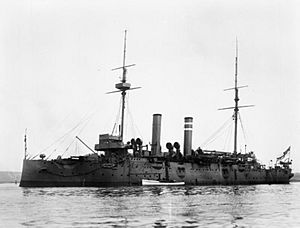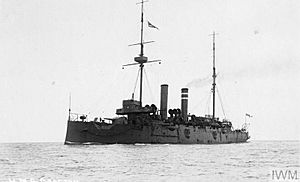HMS Grafton (1892) facts for kids

HMS Grafton
|
|
Quick facts for kids History |
|
|---|---|
| Name | HMS Grafton |
| Builder | Thames Ironworks and Shipbuilding Company |
| Laid down | 1 January 1890 |
| Launched | 30 January 1892 |
| Commissioned | Portsmouth 10 September 1895 |
| Fate | Sold for breaking up 1 July 1920 |
| General characteristics | |
| Class and type | Edgar-class cruiser |
| Displacement | 7,350 tons |
| Length | 387.5 ft (118.1 m) |
| Beam | 60 ft (18 m) |
| Armament |
|
HMS Grafton was a powerful warship called a cruiser. She was part of the Edgar class class of ships. Grafton was launched in 1892. She served the British Empire in different parts of the world. Later, she played a role in the First World War. Grafton survived the war. She was eventually taken apart for scrap metal in the 1920s.
Building a Mighty Warship
Grafton was built at the Thames Ironworks and Shipbuilding Company. This shipyard was located in London. Her construction began on January 1, 1890. She was officially launched into the water on January 30, 1892.
In June 1893, Grafton went through important sea trials. These tests checked how fast and powerful her engines were. She could reach a speed of 19+1⁄2 knots (36.1 km/h; 22.4 mph) using her natural engine power. With extra power, she could go even faster, reaching 20+1⁄5 knots (37.4 km/h; 23.2 mph).
Life at Sea: Grafton's Adventures
Grafton officially joined the Royal Navy on September 10, 1895. Her first big assignment was in the China Sea. She served on the China station from April 1896 to September 1899.
In December 1901, Grafton was sent to the Pacific Station. She became the main ship, or flagship, there. She set sail from Plymouth on January 31, 1902. Her journey took her to places like Madeira, São Vicente, and Montevideo. She finally arrived in Valparaíso, Chile, in mid-March.
In April 1902, Grafton helped solve a problem in Guatemala. The British government wanted a loan repaid. Grafton sent sailors ashore to show force. This show of strength worked, and the government paid the loan. In December that year, she visited several cities. These included Monterey, San Diego, and Acapulco.
On January 31, 1903, something unusual happened. While sailing near Chile, Grafton hit a very large whale. It was estimated to be about 60 feet (18 m) long.
World War I Service
When the First World War started, Grafton was part of the 10th Cruiser Squadron. Her job was to help enforce the naval blockade against Germany. This meant stopping ships from reaching German ports.
By December 1914, ships like Grafton were not ideal for blockade work. So, her two large 9.2-inch guns were removed. These guns were then used to arm other warships called monitors. Grafton and three sister ships were then refitted. They were prepared for bombarding enemy positions on land. This was for the planned operations in the Dardanelles. Two 6-inch guns replaced the larger ones. Also, special anti-torpedo bulges were added to her sides. These bulges helped protect the ship from torpedo attacks. However, they also made the ship about 4 knots (7.4 km/h; 4.6 mph) slower.
Grafton and her sisters served in the Gallipoli Campaign starting in July 1915. She fired her guns at enemy positions during the landing at Suvla Bay. She also helped during the Battle of Sari Bair in August 1915. On August 12, 1915, Turkish shells hit Grafton off Suvla. Nine of her crew members sadly died.
Grafton also helped cover the evacuations of troops. She helped at Anzac Cove in December 1915. She also helped at Cape Helles in January 1916. For her service off Gallipoli, Grafton received a special honor. It was called the "DARDANELLES, Feb 1915- Jan 1916" battle honour.
On June 10, 1917, a German U-boat, UB-43, torpedoed Grafton. This happened about 150 nautical miles (280 km) east of Malta. Luckily, her anti-torpedo bulges worked well. The damage was limited, and no one was hurt. Grafton was able to sail safely into port in Malta. She later took part in the Battle of Jaffa.
Grafton was eventually sold on July 1, 1920. She was taken to Plymouth to be broken up for scrap.


